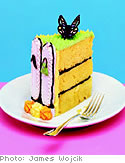
Sit-down for 50 or stand-up-and-mingle for 100? Saturday night or Sunday afternoon? Themes, flowers, music? Nine notable hosts serve up a great big platterful of festive, opinionated, contradictory advice on entertaining.
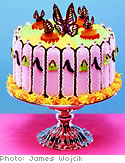
Michele Adams and Gia Russo:
Owners of a lifestyle creative consulting company called MiGi in Los Angeles. Co-authors of At Home with Friends.
Preston Bailey:
Owner of Preston Bailey Entertainment Design in New York City. Author of Preston Bailey's Design for Entertaining.
Colin Cowie:
Event planner with offices in New York City and Los Angeles. Author of many books on style and entertaining, including Colin Cowie's Legendary Weddings.
Patricia Field:
Emmy-winning costume designer for Sex and the City. Owner of Hotel Venus, a boutique in lower Manhattan, and the clothing line House of Field.
Ina Garten:
Author of three Barefoot Contessa cookbooks. Host of Barefoot Contessa, a cooking and entertaining show on the Food Network. Featured in O, The Oprah Magazine.
Nicole Miller:
New York clothing designer and party host who's currently writing a book on entertaining and food.
Debra Ponzek:
Chef-owner of Aux Délices, a specialty food shop and catering business in Connecticut. Co-author, with Geralyn Delaney Graham, of The Summer House Cookbook. Former executive chef at Montrachet in New York City. If dinner is at your house this holiday season, Debra Ponzek has a menu for you!
Carolyne Roehm:
Former fashion designer. Author of six books, including At Home with Carolyne Roehm, an entertaining guidebook organized by season.
Michele Adams:
Saturday night. It gives me the day to get things together.
Gia Russo:
Guests are most relaxed on Saturday night. And you get the best attendance.
Ina Garten:
Saturday night is the hardest night of the week to do a party. It's like New Year's Eve—people expect more. And they stay past my bedtime. Sunday afternoon is hands down the best time. Lunch is easier to make than dinner, and everyone's relaxed after their day off Saturday. People can come around 1, and I can serve a one-course meal—something easy like sandwiches or a frittata—and a nice dessert, and everyone's on their way by 4.
Nicole Miller:
Sunday night. Because Saturdays are always too busy, and Fridays are too complicated. And a lot of people are free on Sundays.
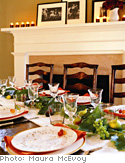
Nicole Miller:
I never give Christmas parties. During the holiday season, everybody has five other parties to go to every night, and yours is always in conflict with somebody else's. If they do come to your party, it's on their way to someplace else.
Gia Russo:
An Oscar® party or a Super Bowl party. To me they're a little cheesy. They're focused on things that are kind of made-up, like Hallmark holidays.
Patricia Field:
The sit-down dinner is too confining for me. I'm much more informal, and my parties are more about moving around and having a cocktail and playing music and socializing. I tend to entertain lots of people, so I usually serve buffet dinners, at room temperature. We just keep mounding up the platters.
Michele Adams:
A sit-down dinner. I feel it's becoming a thing of the past. People are living much more casually and relaxed now.
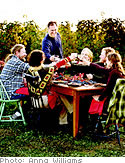
Nicole Miller:
I always do sit-downs. They're for anywhere from 10 to 40 people, and I put everybody at one long banquet table. It's like the Last Supper.
Carolyne Roehm:
I only throw sit-downs. Sometimes that may be as casual as bales of hay covered with blankets in the barn, but I'm not a finger food kind of person, and I hate standing around in high heels. My very favorite dinners have around six to eight people, where you can have an interesting discussion.
Who sits where?
Carolyne Roehm:
If I put someone who's a real talker next to a moderate talker on one side and a shy person on the other, then I know someone's going to carry the ball. There are certain friends to whom I'll say, "Hey, because I love you so much, you've got the work spot."
Nicole Miller:
I always like to put people next to someone they don't know—maybe one person they do know and one person they don't know.
Nicole Miller:
Every party I make has a theme. I've done Thai, Southwestern, Moroccan, Vietnamese. Last year I did a Brazilian dinner because the Brazilians had won the World Cup. I served caipirinhas, a drink made with sugarcane liquor. I covered the whole table with beach sarongs that said copacabana. This year I did a Frida theme, with Frida and Diego place cards, a religious Frida shrine, hundreds of Mexican paper flowers, and just a lot of Mexican stuff.
Gia Russo:
We always do a theme. People get excited to know that there's some kind of a gimmick, some novelty: Mexican, Asian, tropical, or something like a tea party or a sake party with Japanese appetizers, or a chocolate lovers' party with everything from chocolate soda to truffles.
Michele Adams:
I'm big on color. I like to choose a palette that goes with the theme of the party, like deep, rich reds and pinks for Mexican. Sometimes the theme is a color palette, and I create the setting around it.
Preston Bailey:
If you're giving a holiday party, for instance, you can decide to do everything in red—the plates, the glasses, even certain foods. Or another approach: Once I invited 15 of my best friends and told them to bring two of their best friends, and it was really an incredible dynamic.
Carolyne Roehm:
I do a lot of gardening, so my themes are usually based on the seasons, even if sometimes I go against the seasons—I'll decide that, in the middle of January, when there's 10 inches of snow on the ground, I need a sense of summer. But normally I go with the season, like mint juleps, fried chicken, barbecued ribs, and homemade cake on the Fourth of July.
Ina Garten:
I'm not big on themes. I think entertaining is about connecting with friends, and anything that makes the event too important diminishes the connection. My only reason to have a party is to see people I want to see.
Patricia Field:
My old loft was air-conditioned only in my sleeping area, so I never had parties there in the summer. But one time there was a reason to have a party in June, and I had bought this huge stock of vintage stilettos for my shop. So I said, "Let's have a bikini-and-high-heel party." I told everybody to come with their swimsuits. My friend Artie hung all these beach balls and blow-up tubes.
Nicole Miller:
I don't think it matters what you play late in the evening, because everyone is so engrossed in their conversations that they're not listening. It's more important what you play earlier.
Carolyne Roehm:
I go for classical music for the most part, and I stay away from vocals before and during dinner because it's too hard to concentrate on conversation. I like Bach—particularly the Goldberg Variations—Haydn and Vivaldi.
Preston Bailey:
At the beginning of the evening you want something kind of mellow. I'm from Panama, so I start off with classic Latin music. I especially like La Lupe and a singer named India. As the evening progresses, I love R&B, Whitney Houston, Annie Lennox—the temperature goes up a bit. Sometimes, if you realize people are starting to get a little happy, you can put on some dancing music. The host should be in tune with the environment and how people are reacting and follow it. Also, I have friends who are singers, and I have a keyboard, and sometimes someone starts playing and singing, and as soon as one person sings, someone else wants to. People love to sing.
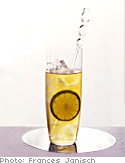
Carolyne Roehm:
If I'm giving a thematic party, I might have margaritas or something like that, but normally I just serve whatever people want to drink. And I'd say 80 percent of them drink wine.
Gia Russo:
Occasionally I'll do a punch bowl, but I try to update it. Maybe by adding some fresh mint to the punch or floating flowers in it, or not serving it in a traditional punch bowl but finding a big container like a giant glass cookie jar that can sit on the table and be really pretty.
Preston Bailey:
I don't drink alcohol, but I'm a big mixer. I have a very good blender, and I'll experiment with different fresh fruits and juices, maybe a bit of wheatgrass for energy, some ginger. You can come up with unexpected frosted drinks, and people love them. Here's one: Take 8 ounces of chopped fresh pineapple, 8ounces of cranberry juice, and a shot of wheatgrass. Mix them in a blender, add five ice cubes, then mix some more.
Colin Cowie:
All sorts of cocktails. I recently made the most delicious, delicious, delicious one: a cocoa-flavored margarita with fresh coconut. And I did one with 2 ounces of passion fruit juice, 1 ounce of mango juice, 2 ounces of ginger ale, and 2 ounces of vodka, with a big wedge of fresh ginger.
Patricia Field:
I like to make a mimosa but with guava. Then I also do a chocolate martini, with vodka and Godiva's white chocolate liqueur and a few pieces of chocolate floating in it. And there's a certain wine I love that a lot of people don't know about called Retsina. It's Greek, and the wine is treated with pine-tree resin, so it has a distinctively pine taste to it. It's unlike any other wine you've ever had.
Ina Garten:
Two ways—have everything done before the guests arrive, and invite people you want to see.
Colin Cowie:
By being organized. You cannot have fun if you're stressed, and unless you're organized, you will be stressed. Before the doorbell rings, I like to make sure all the lights are dimmed and the music is on and the candles are lit and my table is ready and my food is complete.
Gia Russo:
If you're having a lot of people and you want an amazing menu, definitely don't cook everything yourself. Either have people help you or mix store-bought items with home-cooked ones. And set up a self-service bar, or have a bartender, so you're not the one making the drinks and serving everyone all night.
Preston Bailey:
Sometimes I'll order the best dish I've had from a bunch of different restaurants that deliver. Then I'll dress the table beautifully. I'm not afraid of using the containers the food came in—I'm not trying to tell anyone that I cooked it.
Carolyne Roehm:
It was during a very formal dinner for 150 people in the Spanish court of the Metropolitan Museum, and there was a famous violinist performing. Since it was autumn, I decided to serve a rabbit stew. Growing up in the Midwest, we ate rabbit, but I guess New Yorkers see it and think they're eating bunny. One of the more memorable lines was "Oh my God, we're eating Thumper!" Another time there were maybe 14 of us for dinner, and we were having rhubarb pie, and I looked up at a guest, who had a strange, confused look. Then I saw two or three other similar faces, and I thought, Wow, that's odd—not the response I usually get from this pie. Turns out the person who baked the pies this time had substituted salt for sugar, so something that needs a lot of sugar was pure brine. All you can do is laugh.
Preston Bailey:
I did a party for 150 in the Hamptons for a client one summer, and the caterers did not appear at all. There was no food. So what do you do? You improvise. We went to a deli, got a lot of stuff, made fun of it, and made it work. Improvising is the main and most important thing.
Patricia Field:
When we have big parties and the music is blasting, we get the local precinct here. But they know me—I've been in the Village for so many years. There was one wild party where I had just put some new furniture in my place, and the next morning the legs of two sofas were collapsed and the arm on a chair was broken. I said, "Oh, well, that's the price of fun."
Gia Russo:
Yeah. Big. Love flowers. Flowers and candles are the most important things you should have at a party. Just floating flowers in a beautiful bowl is so easy, yet it makes such a wonderful statement. You don't have to spend $200 on an arrangement.
Debra Ponzek:
Before the guests arrive, I always put a flower arrangement on the table, then sit down to make sure I can see the person across from me.
Preston Bailey:
If you have the money for flowers, that's always wonderful, but my biggest thing is encouraging people to play with what they have. You could use leaves to tie napkins and to line your platters, then use bigger leaves as an arrangement. In the summer, there are tons of sunflowers that cost very little. Ten sunflowers could decorate a table because they're so big and impressive.
Colin Cowie:
I don't care for that whole thing of big buckets of flowers. It's costly, and it always looks like someone else did it. I prefer to use sculpted vases with a small opening that require just one or two flowers or beautiful leaves, which become more of an art statement.
Ina Garten:
I don't decorate much. It's one more thing to do, and entertaining is hard enough—to add another thing you should do is nuts. My suggestion to create atmosphere is: Dim the lights, light some candles, make good drinks, and crank up the music.




